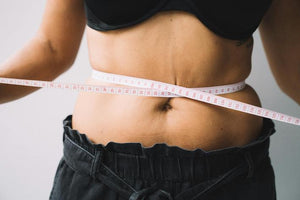A healthy salad with French dressing, chicken and vegetables with ketchup, a cappuccino with oat milk, and a post-workout protein shake. All of these sound like healthy foods, and you probably don't bother to look at the label. After all, what's not healthy about a salad? Isn't oat milk a healthier option than cow's milk? Well, it's always a matter of comparison.
If you look at the labels of some of these foods, you'll notice that many of them contain sugar. Sugar isn't always easy to spot. Often, it's "undercover," hidden under other names. So let's look at some foods you wouldn't suspect contain tons of sugar. Especially the store-bought ones.
Salad dressing
The image below shows a blood sugar spike caused by a supposedly healthy salad. It was packed with vegetables (fiber), salmon (fat and protein), and other greens. This is the perfect combination to keep blood sugar stable. Then the dressing comes in. And the whole curve changes for the worse. In this case, the dressing was responsible for the sharp rise and the rapid drop in the curve.
Did you know that store-bought salad dressings can contain up to 16-20 g of sugar per 100 ml. That's about 4-5 sugar cubes. And the same goes for salads when you eat out.
Our tip: Use olive oil and apple cider vinegar. Or order the dressing separately so you can decide how much to add.

Sauces
Sauces like BBQ dips or ketchup can contain a lot of sugar—up to 20g per 100g; that's about the equivalent of 5 sugar cubes. It's quite frightening when you take a closer look. So what are your options? Skip the sauces or make them yourself.
Dips & Spreads
Hummus, baba ganoush, or veggie dips. They all sound incredibly delicious. All of these dips are made from super-healthy ingredients and are fantastic options for your snacks. When buying them at the supermarket, be extra careful and check the food label for sugar content. You'll be surprised by the ingredients and the hidden sugar.
Coffee drinks
A flavored coffee or a Frappuccino is a real treat. And we recommend treating these coffee drinks as something special and exceptional. Most of these treats are more like desserts than "drinks or refreshments." One Frappuccino contains almost 400 kcal. This is almost the recommended energy intake (500 kcal) for a main meal (breakfast/lunch/dinner). A large portion of these calories comes from the 45 g of sugar. The World Health Organization (WHO) recommends consuming less than 25 grams of sugar per day. This also means that one Frappuccino will use up your sugar budget for two days.
Muesli
36.7% of Germans eatcereal for breakfast at least 5-6 times a week. That's a lot of sugar, as a single serving of store-bought cereal can contain up to 40g of sugar. This could explain why many people suffer from cravings or a lack of energy throughout the day. These symptoms are due to the fact that the choice of breakfast causes blood sugar levels to spike, only to plummet again shortly afterward.
Our tip: Get creative and make your own muesli. Great ingredients include goji berries, coconut flakes, flaxseeds, cocoa nibs, seeds, and nuts.
Milk alternatives
Are plant-based alternatives healthier than dairy? There's no clear answer. Every milk alternative is different, and some contain a lot of sugar. While oat milk is very likely to spike blood sugar levels because it's high in carbohydrates, soy milk may be a better choice. It's lower in carbohydrates and contains protein, which helps stabilize blood sugar levels.
Our tip: Always check the food label for milk alternatives and make sure you choose a product without added sugar.
Below you can see the curve from one of our team experiments, in which we tested the effects of milk and milk alternatives on our blood sugar.

yogurt
Many fruit yogurts also contain a large amount of sugar. This can be misleading, as we recommend combining fruit with some yogurt. Unfortunately, this isn't the same as the store-bought version. When making fruit yogurt, the fruit loses its important fiber, and sugar is added on top. So it's a double whammy. A 200g serving can contain up to 6 sugar cubes.
Our tip: Buy natural yogurt and add your own fruits, berries, and a few seeds and nuts. The difference to your blood sugar and your taste buds will be remarkable.
Fruit juices & smoothies
Imagine eating 3 oranges or 4 apples in one sitting. You probably wouldn't do that, especially not in such a short period of time. But that's roughly the same amount you'd consume if you drank a glass of fruit juice . This contains 20g of sugar. So it's no surprise that these drinks are your ticket to the glucose roller coaster you'll end up on. Plus, store-bought juices can contain added sugar.
Our tip: Eat your fruit whole and have it with nuts or yogurt for dessert. And replace your orange juice for breakfast with a glass of water with lemon or berries.
Frozen and canned food
Many things you find in the canned or frozen food aisles contain sugar, and plenty of it. The next time you reach for that frozen pizza, fish sticks, or canned vegetables, check the food label and see how much sugar you can find.
Bread
Have you ever checked the ingredients in your toast? We recommend you take a closer look next time. Most packaged breads contain a lot of sugar as a preservative to extend their shelf life. All of this sugar then ends up in your body.
Our tip: Try baking your own bread or get sourdough bread from your local bakery.
Protein bars & shakes
We live in a world where protein shakes and bars are part of a healthy lifestyle. But like many of the products mentioned above, these can contain a lot of sugar. So check the ingredients list carefully if you want to avoid blood sugar spikes and feel tired soon afterward.
tomato sauce
Pasta, pizza, lasagna. We love them all. And they all taste great with just a little tomato sauce. For convenience, we buy the sauce ready-made. But it's actually quite easy to make your own, and this way you can avoid the 10 g of added sugar per 100 ml.
How to find hidden sugar in food
It's always a good idea to check a food label if you're unsure or simply want to learn more. You'll always find something surprising. And with a little practice, you'll know how to choose the right foods to avoid excessive sugar consumption. Most of these added sugar traps are easy to avoid.
If you want to find your own sweet spot and see what's happening in your body, you should try our new 14-day Hello Sugar program and measure your blood sugar. Get your Hello Inside subscription now.





